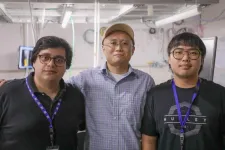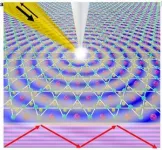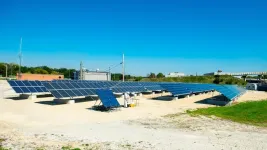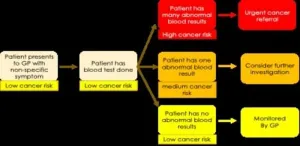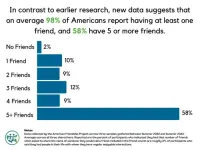(Press-News.org) In traditional Japanese basket-weaving, the ancient “Kagome” design seen in many handcrafted creations is characterized by a symmetrical pattern of interlaced triangles with shared corners. In quantum physics, the Kagome name has been borrowed by scientists to describe a class of materials with an atomic structure closely resembling this distinctive lattice pattern.
Since the latest family of Kagome metals was discovered in 2019, physicists have been working to better understand their properties and potential applications. A new study led by Florida State University Assistant Professor of Physics Guangxin Ni focuses on how a particular Kagome metal interacts with light to generate what are known as plasmon polaritons — nanoscale-level linked waves of electrons and electromagnetic fields in a material, typically caused by light or other electromagnetic waves. The work was published in Nature Communications.
Previous research has examined plasmons in regular metals, but not as much in Kagome metals, where the behavior of electrons is more complex. In this study, the FSU researchers examined the metal cesium vanadium antimonide, also known by its chemical formula CsV3Sb5, to better understand the properties that make it a promising contender for more precise and efficient photonic technologies.
The researchers identified for the first time the existence of plasmons in CsV3Sb5 and found that the wavelength of those plasmons depends upon the thickness of the metal.
They also found that changing the frequency of a laser shining at the metal caused the plasmons to behave differently, turning them into a form known as “hyperbolic bulk plasmons,” which spread through the material rather than staying confined to the surface. As a result, these waves lost less energy than before, meaning they could travel more effectively.
“Hyperbolic plasmon polaritons are rare in natural metals, but our research reveals how electron interactions can create these unique waves at the nanoscale,” Ni said. “This breakthrough is key for advancing technologies in nano-optics and nano-photonics.”
To explore how plasmons interacted with the metal, the researchers grew single crystals of CsV3Sb5 and then placed thin flakes of the material onto specially prepared gold surfaces. By using lasers to perform scanning infrared nano-imaging, they observed how the metal’s plasmon polaritons — waves of electrons interacting with electromagnetic fields — changed in interesting ways.
“What makes CsV3Sb5 interesting is how it interacts with light on a very small scale, what’s known as nano-optics,” said lead author Hossein Shiravi, a graduate research assistant at the FSU-headquartered National High Magnetic Field Laboratory. “We found that over a wide range of infrared light frequency, the correlated electrical properties within the metal triggered the formation of hyperbolic bulk plasmons.”
That hyperbolic pattern means less energy is lost. The team’s findings reveal new information about the way Kagome metal CsV3Sb5 behaves under various conditions, providing researchers with a more accurate picture of its properties and potential real-world applications.
“Hyperbolic plasmon polaritons can offer a range of amazing nano-optical features and abilities,” Ni said. “They have the potential to boost optical communication systems, allow for super-clear imaging beyond current limits and make photonic devices work better. They could also be useful for sensing things like environmental changes and medical diagnostics because they react strongly to their surroundings. These qualities make them key for advancing future optical and photonic technologies.”
The CsV3Sb5 metal was a promising choice for plasmon research because of its unusual electronic and optical properties, such as its potential ability to force waves of plasmons to move in a single direction, to name just one. Recent advances in imaging technology at the nano-scale level helped the researchers complete their work.
“Electronic losses typically encountered in conventional metals have previously complicated efforts to observe exotic light-matter coupling effects, including hyperbolic polaritons,” Ni said. “This is part of what makes this an exciting breakthrough. It will be interesting to continue exploring nano-optical phenomena in unconventional metals owing to their potential to contribute to future technologies.”
FSU graduate student Aakash Gupta was also a coauthor on this study. The study was conducted in collaboration with researchers from the University of California Santa Barbara, Oak Ridge National Laboratory in Tennessee, Tsinghua University in China, and Germany’s University of Stuttgart, Leipzig University, and Institute of Ion Beam Physics and Materials Research. At FSU, this research is supported by funding from the U.S. Department of Energy and National Science Foundation.
To learn more about physics research at FSU, visit physics.fsu.edu.
END
FSU researchers identify unique phenomenon in Kagome metal
2024-07-30
ELSE PRESS RELEASES FROM THIS DATE:
Ochsner-Xavier Institute for Health Equity and Research publishes strategic plan
2024-07-30
NEW ORLEANS – The Ochsner-Xavier Institute for Health Equity and Research, or OXIHER, has published its first strategic plan, outlining strategic priorities and achievements since the institute began in 2020.
The strategic plan is available here.
A partnership between Ochsner Health and Xavier University of Louisiana, OXIHER examines health disparities at the community level while educating healthcare providers on creating and nurturing a culture of equity, and training more students for advanced careers in healthcare.
The new plan details OXIHER’s substantial progress in its first three years in addressing ...
Argonne receives U.S. Department of Energy funding for four next-generation clean-energy projects
2024-07-30
The U.S. Department of Energy’s (DOE) Argonne National Laboratory has been awarded funding from DOE’s Office of Technology Transitions for four new projects that will help with commercialization of innovative clean-energy technology for a sustainable future.
Argonne scientists will work to turn their innovative ideas into next-generation technology necessary to build cleaner, more resilient energy systems. These projects build on Argonne’s decades-long role at the forefront of the quest to decarbonize ...
Researchers develop general framework for designing quantum sensors
2024-07-30
Researchers from North Carolina State University and the Massachusetts Institute of Technology have designed a protocol for harnessing the power of quantum sensors. The protocol could give sensor designers the ability to fine-tune quantum systems to sense signals of interest, creating sensors that are vastly more sensitive than traditional sensors.
“Quantum sensing shows promise for more powerful sensing capability that can approach the fundamental limit set by the law of quantum mechanics, but the challenge lies in being able to direct ...
UBC super-black wood can improve telescopes, optical devices and consumer goods
2024-07-30
Thanks to an accidental discovery, researchers at the University of British Columbia have created a new super-black material that absorbs almost all light, opening potential applications in fine jewelry, solar cells and precision optical devices.
Professor Philip Evans and PhD student Kenny Cheng were experimenting with high-energy plasma to make wood more water-repellent. However, when they applied the technique to the cut ends of wood cells, the surfaces turned extremely black.
Measurements by Texas A&M University’s ...
Repair kit for NASA’s NICER mission heading to space station
2024-07-30
NASA will deliver a patch kit for NICER (Neutron star Interior Composition Explorer), an X-ray telescope on the International Space Station, on the agency’s Northrop Grumman 21st commercial resupply mission. Astronauts will conduct a spacewalk to complete the repair.
Located near the space station’s starboard solar array, NICER was damaged in May 2023. The mission team delivered the patch kit to NASA’s Johnson Space Center in Houston in May 2024 so it could be prepped and packed for the upcoming resupply mission.
“It’s ...
Mucus-based bioink could be used to print and grow lung tissue
2024-07-30
Lung diseases kill millions of people around the world each year. Treatment options are limited, and animal models for studying these illnesses and experimental medications are inadequate. Now, researchers describe in ACS Applied Bio Materials their success in creating a mucus-based bioink for 3D printing lung tissue. This advance could one day help study and treat chronic lung conditions.
While some people with lung diseases receive transplants, donor organs remain in short supply. As an alternative, medications and other treatments can be used to manage symptoms, but no cure is available for disorders such as chronic obstructive ...
Who is more polarized about AI—the tech community or the general public?
2024-07-30
The tech community is more strongly divided in how they feel about artificial intelligence (AI) than the general public according to a study of Reddit discourse following the launch of ChatGPT.
Researchers from the University of Rochester led by Jiebo Luo, a professor of computer science and the Albert Arendt Hopeman Professor of Engineering, used ChatGPT and natural language processing techniques to analyze the themes and sentiments of 33,912 comments in 388 unique subreddits in the roughly six months following the generative AI tool’s launch in November 2022. The findings appear in Telematics and Informatics.
Reddit is an online social ...
Routine blood test results can improve cancer risk assessment in patients with abdominal symptoms
2024-07-30
Incorporating information from common blood tests can enhance cancer risk assessment in patients with abdominal symptoms, according to a study publishing July 30th in the open-access journal PLOS Medicine by Meena Rafiq from University College London, UK, and colleagues.
Early cancer detection is key to successful treatment. However, many undiagnosed cancer patients present to their primary care provider with non-specific symptoms that can be a result of several other benign causes, making it difficult ...
Friendships in America may be in less peril than previously thought
2024-07-30
American adults may typically have more friends than indicated by other recent surveys, with fewer Americans having no friends at all – though many would like closer friendships. Natalie Pennington of Colorado State University, US, and colleagues present these preliminary findings from the ongoing “American Friendship Project” in a study published July 30, 2024, in the open-access journal PLOS ONE.
Having more and higher quality friendships is linked with greater happiness and life satisfaction. However, research suggests that ...
Common blood tests could improve cancer diagnosis for people with stomach pain or bloating
2024-07-30
The results of routine blood tests could be used to speed up cancer diagnosis among people with stomach pain or bloating, suggests a new study led by UCL researchers.
Most people who report these symptoms to their GP are referred for blood tests. However, it is not known how well these blood tests, used to explore a range of possible causes of ill health, can predict cancer risk.
The new study, published in PLOS Medicine, looked at data from more than 400,000 people aged 30 or older in the UK who had visited a GP due to stomach ...
